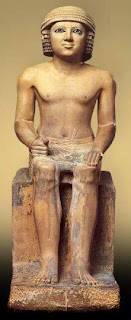Wooden statue of a servant carrying a chicken and balancing a basket on her head. It is finely carved and painted, and is one of the best examples of this type.
This large slender woman was discovered in a secret chamber in the tomb of Meketrê. Looking at this pretty picture, you can see the difference between work done in a wood and stone. Similar conventions guide the artist, but more flexible and tolerant of wood allows the sculptor to release the entire body, including the arts, and create what is truly a piece of sculpture in the round.
Probably the two most important types of models offering bearers and boats. Carriers have offered some of the highest figures, and from a few early Egyptian times. They tend to be female, although offering bearers males are also encountered. Females usually carry food, while the male variety tend to wear religious items. The first offering bearers are simple ceramic figurines, but later they were often made with great art, competing with the statues of the tomb owner himself. This is probably an indication of the importance the Egyptians placed on this particular variety of models, believing that their life after death depended on these workers symbolic.
The figure holds a live duck wings in one hand and balancing a basket of food in the head with the other. In rural areas Egyptians still carry heavy loads on their heads, and people in many parts of the world.
This figure is greater than other products because it embodies a set Meketrê Heritage determined to be the source that would provide offerings for his funerary cult indefinitely. Size, broad collar, bracelets, anklets, and dress to indicate its importance. The grounds of her dress represent small feathers, and the vertical stripes of the skirt, long wing feathers. Goddesses are often depicted in similar costumes. Here the dress is probably referring to Isis and Nephthys, both protected the dead in the afterlife. Interestingly, for the supply of the action is important, women can travel offers - a pose usually reserved for men. Figure Cairo companion is wearing a suit made on the remuneration of pearls.

Since the statue is made of wood, must have been cut in the approximately cylindrical shape of a tree trunk, but the square base and the facade, the installation conforms to the balanced style of stone carving right. Unlike the case of stone carving, however, the wooden figures in space between the body and limbs is open, creating a more realistic look. The colors and patterns, and large eyes and slender, subtly naturalistic form, are arrested. The gray-green, in particular, but also the wig on his head, perhaps was originally blue, hair color gods. Weapons, is duck base, and the trash were made separately and then attached to the body.
.jpg)



















